Crop details
Kale (Brassica oleracea)
Variety (acephala)
Local name :sukumawiki
General information
Kale, Brassica oleracea variant acephala, is a leafy herbaceous biennial or perennial plant in the family Brassicaeae grown as a leafy green vegetable. The kale plant is a non-heading, cabbage like plant with curly or straight, loose blue-green or purple leaves. Kale is usually grown as as an annual plant, harvested after one growing season and can reach a height of 1 m (3.3 ft). Kale may also be referred to as borecole or non-heading cabbage or broccoli and its exact origins are unknown, although it grows native in regions of the eastern Mediterranean and Asia.

Harvested curly kale

Young kale leaves

Kale foliage

Close-up view of kale leaf

Curly kale variety

Kale
Kale Nutrition
Kale is a nutritious food rich in antioxidants, vitamin C, vitamin K, and beta-carotene. It also contains nutrients that can support eye health, weight management and heart health. Loaded with important micronutrients and antioxidants, kale is one of the most nutritious leafy greens available.
In fact, kale contains a variety of beneficial compounds, some of which have powerful medicinal properties. it’s versatile and boasts a nutty, earthy flavour that works well in a wide range of recipes.
uses
Kale is used as a green vegetable and is usually cooked before consumption. Some varieties of kale are grown as decorative ornamental plants due to their attractive, brightly colored foliage.
Kale Variety
"Thousand Headed"
This is a continuous growing and hardy crop that is tolerant to cold temperatures. It can stay in the field for a long time, therefore, giving a higher yield. It has a thick stem with big leaves that are dark green, smooth and attractive. It matures between 90-100 days. It can also be used as fodder for animals. It is easily digestible and easy to cook.
"Southern Georgia"
It is a very popular seed variety grown across Africa. It has been developed to give high yields while up to 6 months before flowering thus profitable to farmers. The leaves are well flavored and easy to cook. It is popular in the local market. It is adapted to hot areas. It is hardy and resistant to black rot.
"Marrow Stem"
The variety has dark green leaves and flavor and little fiber. It is vigorous, medium tall with finely curled leaves which are less prone to bird damage.
Kale growing in Kenya
In Kenya, kale is mainly grown in the highlands, which are located in the central, western, and parts of the eastern regions of the country. These regions have a cool climate, and the soil is rich in nutrients, which is ideal for growing kale. Examples of these regions include the Mount Kenya region, the Aberdares, and the Elgeyo Marakwet.
Propagation
Climatic conditions and soil type
Kale is cool season crop that grows best in cool, moist conditions. The plant will grow best at temperatures between 4 and 21°C (40–50°F) allowing it to be grown in both Spring and Fall. Kale is a hardy plant, tolerating frost, and will grow optimally in a rich, moist, well draining soil with a pH of 6.5. Kale requires at least six hours of direct sunlight every day.
Sowing seeds
Kale can be direct seeded or started indoors for transplants. The optimum soil temperature for germination is between 12 and 24°C (55–75°F). Kale seeds should be planted after any danger of hard frost or in a cold frame for transplanting to their final location. For a Fall harvest, try to time seeding so that the plants will mature in cool weather. This often means sowing in July but may be as late as October in warmer Southern regions. Prepare the soil for planting through the addition of nitrogen in the form of bone meal or composted manure. Plant seeds 12 mm (0.5 in) deep allowing 3.5 cm (1 in) between plants in the row. Thin seedlings to a final within row spacing of 45–60 cm (18–24 in). Keep soil moist during germination to prevent a crust from forming on the soil surface as this will cause uneven germination.
Transplanting
Seedlings started indoors or in a cold frame are ready to be transplanted when they have 3–4 leaves and the daytime temperature has reached 10°C (50°F). Seedlings should be planted at the final spacing for seeds (45–60 cm/18–24 in between plants and 0.6 to 1.2 m/2–4 ft between rows). Plant each seedling slightly deeper than it was previously. The plantings can be staggered in 2 week intervals to prolong the harvest. General care Kale should be kept evenly watered, application of mulch around plants helps to conserve soil moisture. The plants have shallow roots and in order to avoid damaging them, it is preferable to hand pull any weeds growing around the plants. Kale plants are heavy feeders, requiring plentiful nitrogen to meet their growth requirements and develop optimally. Apply an appropriate complete fertilizer when thinning seedlings.
Harvesting
Kale leaves can be harvested when they are 20–25 cm (8–10 in) long. Harvest the outer leaves to avoid damaging the growing tip of the plant. Kale leaves are sweeter when they are harvested after frost.
References
Anderson, C. R. Home Gardening Series. Kale. University of Arkansas Division of Agriculture. Available at: http://www.uaex.edu/publications/pdf/fsa-6069.pdf. [Accessed 21 December 14].
Free to access.
Drost, D. & Johnson, M. (2005). Kale in the Garden. Utah State University Extension. Available at: http://extension.usu.edu/boxelder/files/uploads/Vegetable%20Gardens/KALE0505.pdf. [Accessed 21 December 14].
Free to access.
Rimmer, S. R., Shattuck, V. I. Buchwaldt, L. (Eds) (2007). Compendium of Brassica Diseases. American Phytopathological Society Press. Available at: http://www.apsnet.org/apsstore/shopapspress/Pages/42848.aspx.
Available for purchase from APS Press.
Common Pests and Diseases
Diseases
Category : Fungal
Alternaria leaf spot (Black spot, Gray spot)
Alternaria brassicae
Alternaria brassicicola
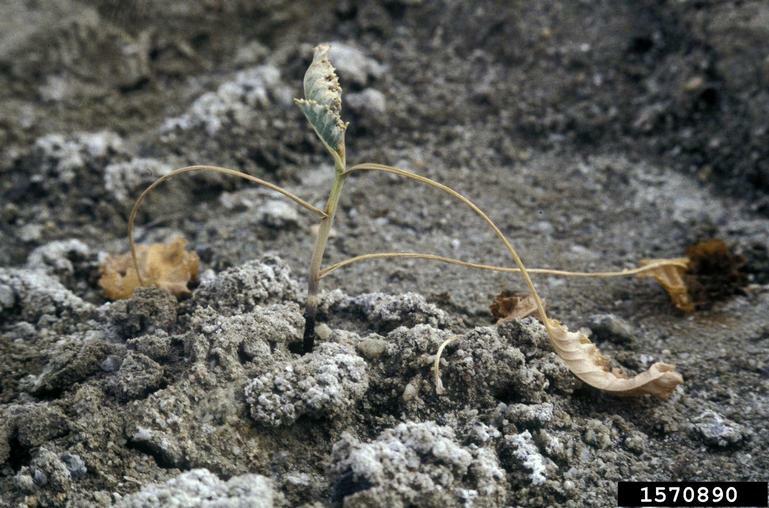
Alternaria as a secondary invader of kale stem tissue.

Black spot of collard and kale caused by Alternaria brassicae or A. brassicicola
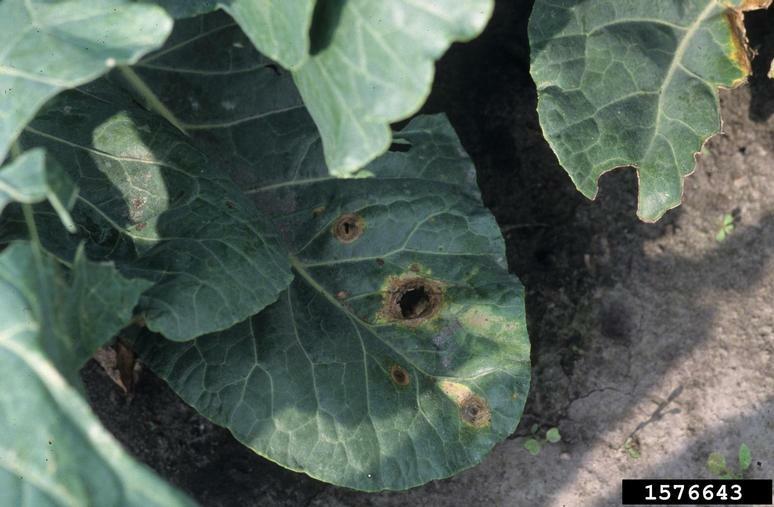
Black spot of collard and kale

Alternaria black molds / stem cankers (Alternaria spp.) on kale
Symptoms
Small dark spots on leaves which turn brown to gray; lesions may be round or angular and may possess a purple-black margin; lesions may form concentric rings, become brittle and crack in center; dark brown elongated lesions may develop on stems and petioles.
Cause
Fungus
Comments
Management
Plant only pathogen-free seed; rotate crops; applications of appropriate fungicides control disease when present.
Anthracnose
Colletotrichum higginsianum
Symptoms
Small circular or irregularly shaped dry spots which are gray to straw in color on leaves; a high number of spots may cause the leaf to die; lesions may coalesce to form large necrotic patches causing leaves to turn yellow and wilt; lesions may split or crack in dry centers
Cause
Fungus
Comments
Management
Control of disease depends on sanitary practices; treat seeds with hot water prior to planting; rotate crops; plant in an area with good soil drainage; remove all cruciferous weeds which may act as a reservoir for the fungus
Damping-off (Wirestem)
Rhizoctonia solani
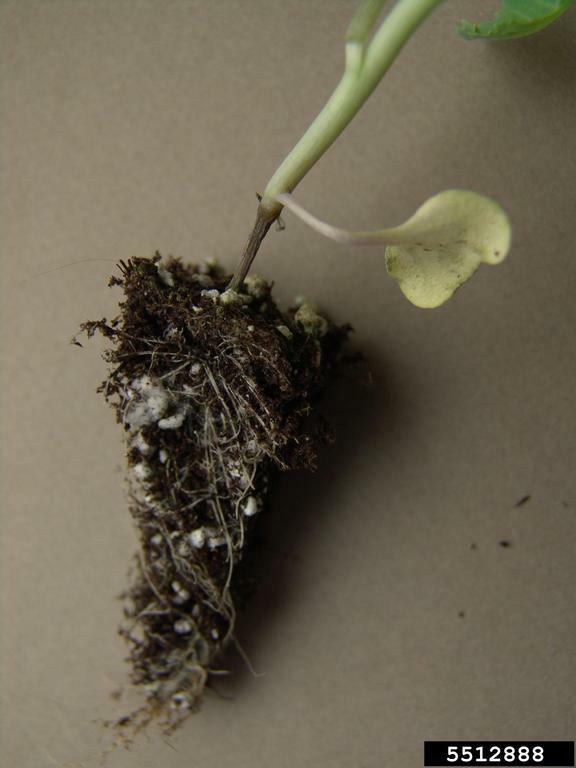
Rhizoctonia damping-off of Brassica

Rhizoctonia damping-off, blight and rot (Rhizoctonia solani) J.G. Kühn on Brassica.
Symptoms
Death of seedlings after germination; brown or black rot girdling stem; seedling may remain upright but stem is constricted and twisted (wirestem).
Cause
Fungus
Comments
Management
Plant pathogen-free seed or transplants that have been produced in sterilized soil; apply fungicide to seed to kill off any fungi; shallow plant seeds or delay planting until soil warms.
Downy mildew
Peronospora parasitica
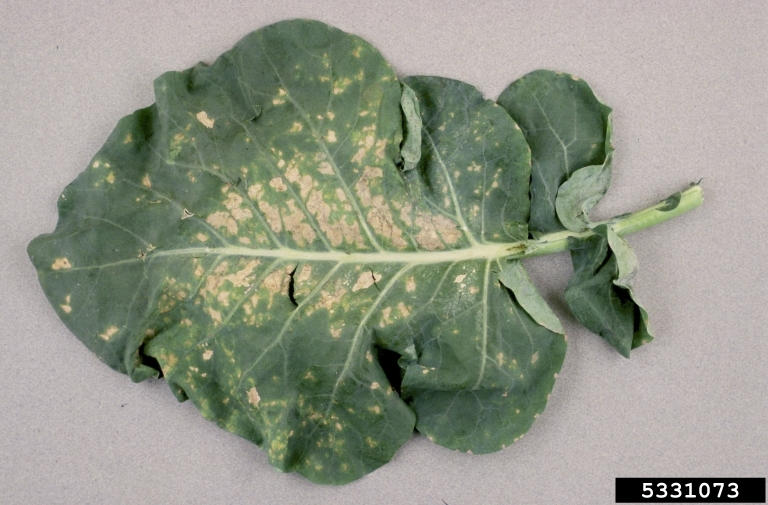
Symptoms of downy mildew (Peronospora parasitica) on brassica

Yellow spots on top of leaf, whitish mold on the bottom of the leaf. Lesions on undersides of leaf are often restricted by veins

Downy mildew (Peronospora parasitica) on brassica
Symptoms
Irregular yellow patches on leaves which turn light brown in color; fluffy gray growth on the undersides of the leaves.
Cause
Fungus
Comments
Management
Remove all crop debris after harvest; rotate with non-brassicas; application of appropriate fungicides may be required if symptoms of disease are present.
Category : Bacterial
Black rot (Leaf spot)
Xanthomonas campestris
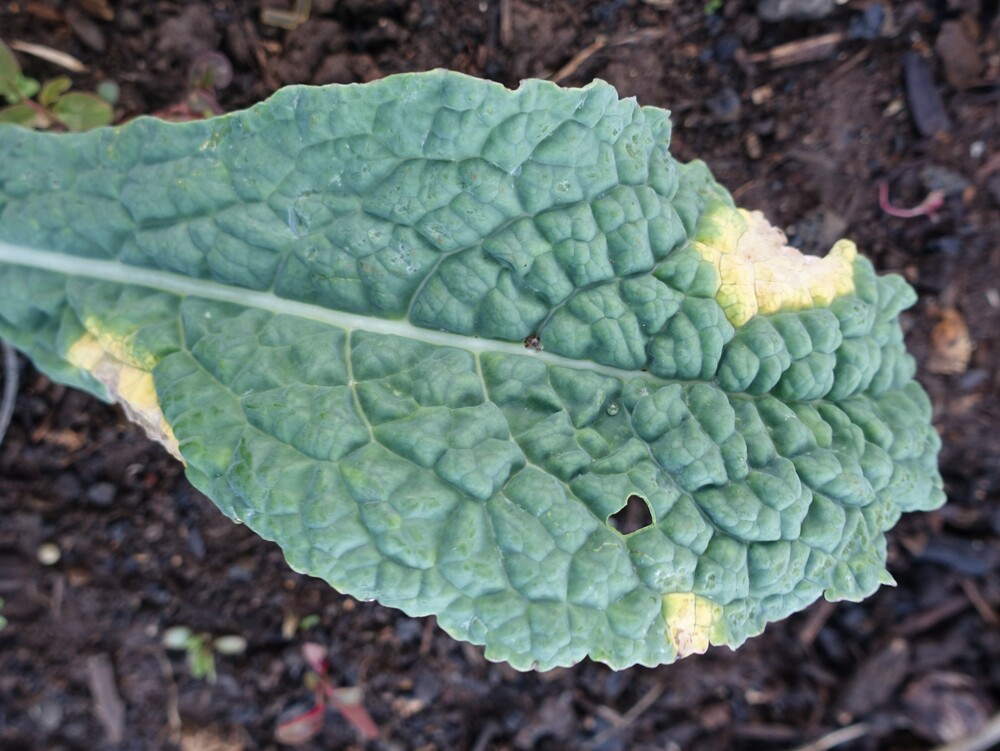
Black rot symptoms on kale

Symptoms on kale
Symptoms
V-shaped brown lesions originating from edge of leaves; black leaf stems and drop from the plant; black discoloration of stem; brown spots on leaves.
Cause
Bacteria
Comments
Management
Primary method of controlling black rot is through the use of good sanitation practices; rotate crops to non-cruciferous crops every 2 years; plant resistant varieties; control cruciferous weed species which may act as a reservoir for bacteria; plant pathogen-free seed.
Pests
Category : Insects
Beet armyworm
Spodoptera exigua

Young larvae

Beet armyworm eggs covered in white hairs

Beet armyworm larva
Symptoms
Singular, or closely grouped circular to irregularly shaped holes in foliage; heavy feeding by young larvae leads to skeletonized leaves; shallow, dry wounds on fruit; egg clusters of 50-150 eggs may be present on the leaves; egg clusters are covered in a whitish scale which gives the cluster a cottony or fuzzy appearance; young larvae are pale green to yellow in color while older larvae are generally darker green with a dark and light line running along the side of their body and a pink or yellow underside.
Cause
Insect
Comments
Management
Organic methods of controlling the beet armyworm include biological control by natural enemies which parasitize the larvae and the application of Bacillus thuringiensis; there are chemicals available for commercial control but many that are available for the home garden do not provide adequate control of the larvae.
Cabbage aphid
Brevicoryne brassicaea
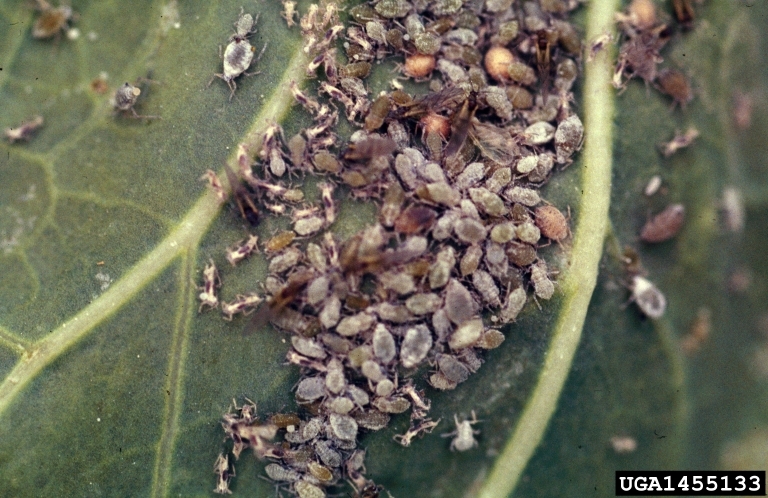
Colony with parasitized aphid

Cabbage aphid colony on Brassica spp.

Cabbage aphid colony
Symptoms
Large populations can cause stunted growth or even plant death; insects may be visible on the plant leaves and are small, grey-green in color and soft bodied and are covered with a white waxy coating; prefer to feed deep down in cabbage head and may be obscured by the leaves.
Cause
Insect
Comments
Management
If aphid population is limited to just a few leaves or shoots then the infestation can be pruned out to provide control; check transplants for aphids before planting; use tolerant varieties if available; reflective mulches such as silver colored plastic can deter aphids from feeding on plants; sturdy plants can be sprayed with a strong jet of water to knock aphids from leaves; insecticides are generally only required to treat aphids if the infestation is very high - plants generally tolerate low and medium level infestation; insecticidal soaps or oils such as neem or canola oil are usually the best method of control; always check the labels of the products for specific usage guidelines prior to use.
Cabbage looper
Trichoplusia ni
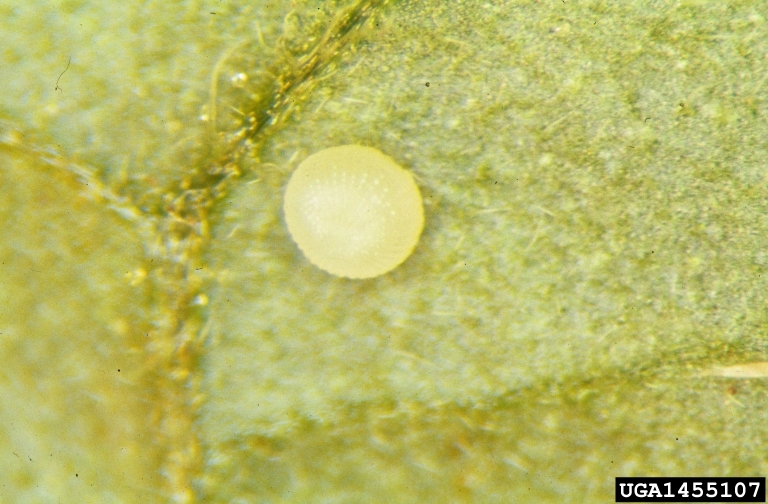
Cabbage loopers egg

Cabbage looper adult

Cabbage looper
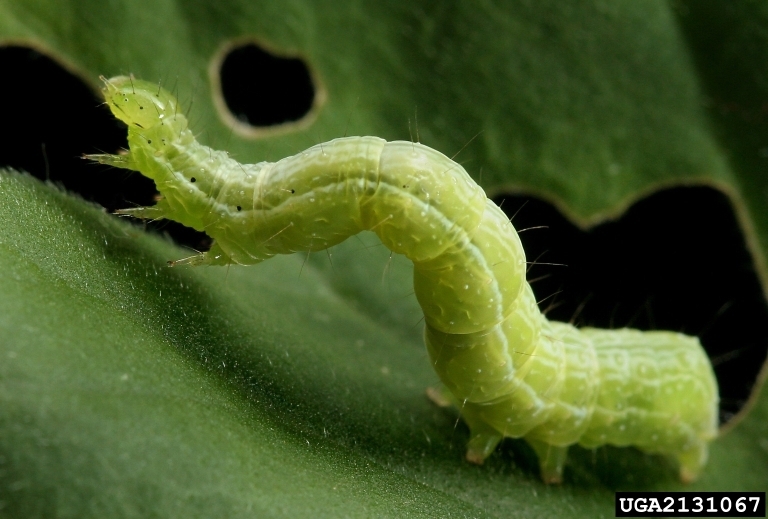
Cabbage looper (Trichoplusia ni)

cabbage looper feeding on leaves

Cabbage looper and damage
Symptoms
Large or small holes in leaves; damage often extensive; caterpillars are pale green with a white lines running down either side of their body; caterpillars are easily distinguished by the way they arch their body when moving; eggs are laid singly, usually on the lower leaf surface close to the leaf margin, and are white or pale green in color.
Cause
Insect
Comments
Management
Looper populations are usually held in check by natural enemies; if they do become problematic larvae can be hand-picked from the plants; an organically acceptable control method is the application of Bacillus thuringiensis which effectively kills younger larvae; chemical sprays may damage populations of natural enemies and should and should be selected carefully.
Cutworms
Agrotis spp.
Peridroma saucia
Nephelodes minians
and others

Army cutworm (Euxoa auxiliaris)

Cutworm feeding on plant stem

Bronzed cutworm (Nephelodes minians) adult

Cutworms will curl up into a characteristic C shape when disturbed

Greasy cutworm (Agrotis ipsilon aneituma) adult

Cutworm larva severing plant stem
Symptoms
Stems of young transplants or seedlings may be severed at soil line; if infection occurs later, irregular holes are eaten into the surface of fruits; larvae causing the damage are usually active at night and hide during the day in the soil at the base of the plants or in plant debris of toppled plant; larvae are 2.5–5.0 cm (1–2 in) in length; larvae may exhibit a variety of patterns and coloration but will usually curl up into a C-shape when disturbed.
Cause
Insects
Comments
Management
Remove all plant residue from soil after harvest or at least two weeks before planting, this is especially important if the previous crop was another host such as alfalfa, beans or a leguminous cover crop; plastic or foil collars fitted around plant stems to cover the bottom 3 inches above the soil line and extending a couple of inches into the soil can prevent larvae severing plants; hand-pick larvae after dark; spread diatomaceous earth around the base of the plants (this creates a sharp barrier that will cut the insects if they try and crawl over it); apply appropriate insecticides to infested areas of garden or field if not growing organically.
Diamondback moth
Plutella xylostella

Diamondback moth early instar larva

Diamondback moth adult
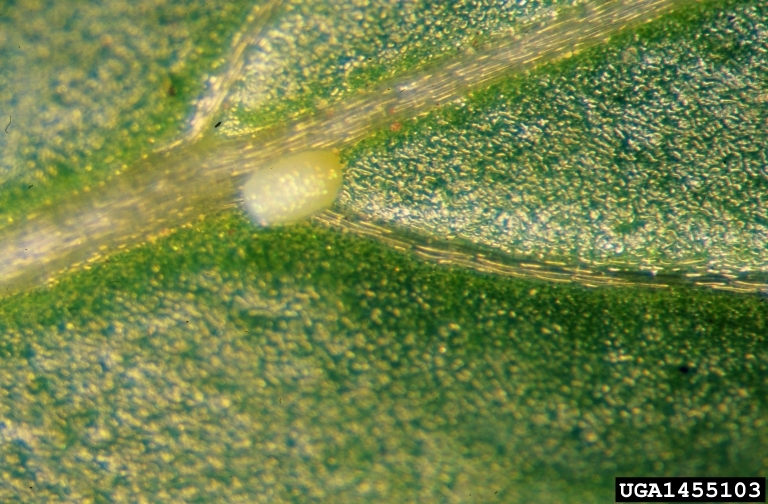
Diamondback moth egg

Larva feeding on cabbage leaf
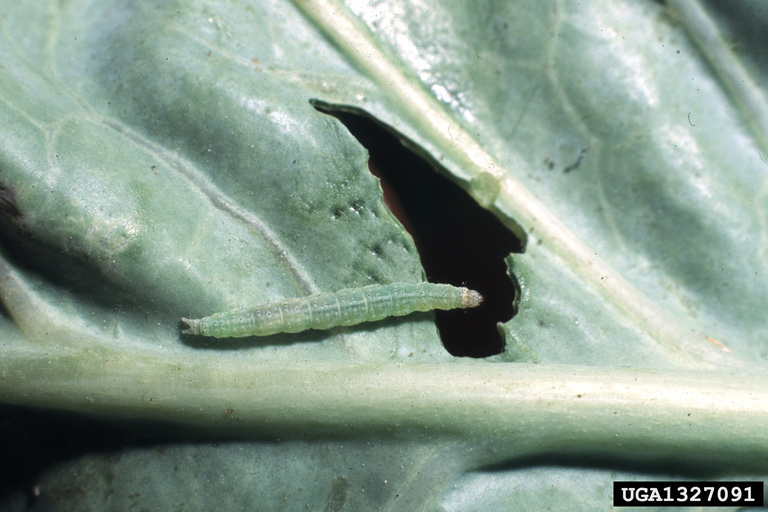
Diamondback moth feeding on Brassicae

Diamondback moth pupae
Symptoms
Young larvae feed between upper and lower leaf surface and may be visible when they emerge from small holes on the underside of the leaf; older larvae leave large, irregularly shaped shotholes on leaf undersides, may leave the upper surface intact; larvae may drop from the plant on silk threads if the leaf is disturbed; larvae are small (1 cm/0.3 in) and tapered at both ends; larvae have to prolegs at the rear end that are arranged in a distinctive V-shape.
Cause
Insect
Comments
Management
Larvae can be controlled organically by applications of Bacillus thurengiensis or Entrust; application of appropriate chemical insecticide is only necessary if larvae are damaging the growing tips of the plants.
Flea beetles
Phylotreta spp.
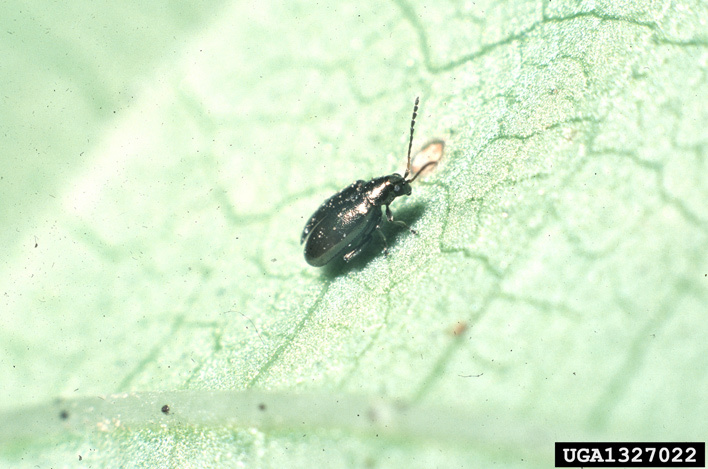
Adult flea beetle on a leaf

crucifer flea beetle (Phyllotreta cruciferae) on Chinese cabbage.
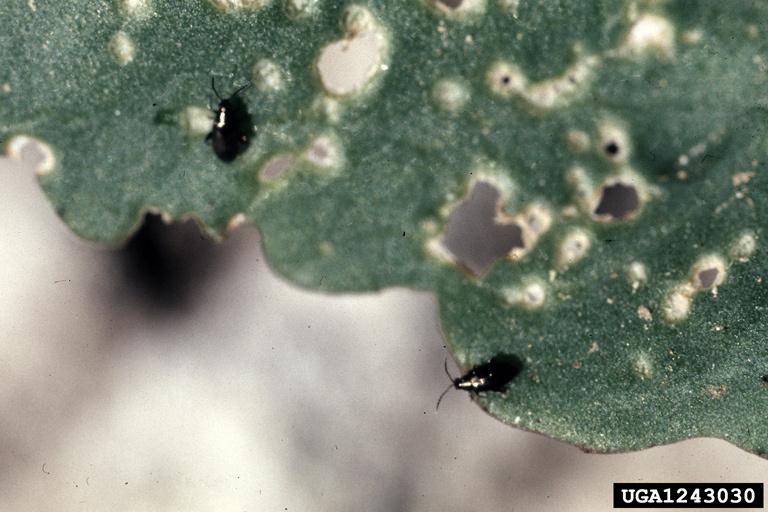
Adults and associated damage on cabbage

Crucifer flea beetle damage on broccoli leaf
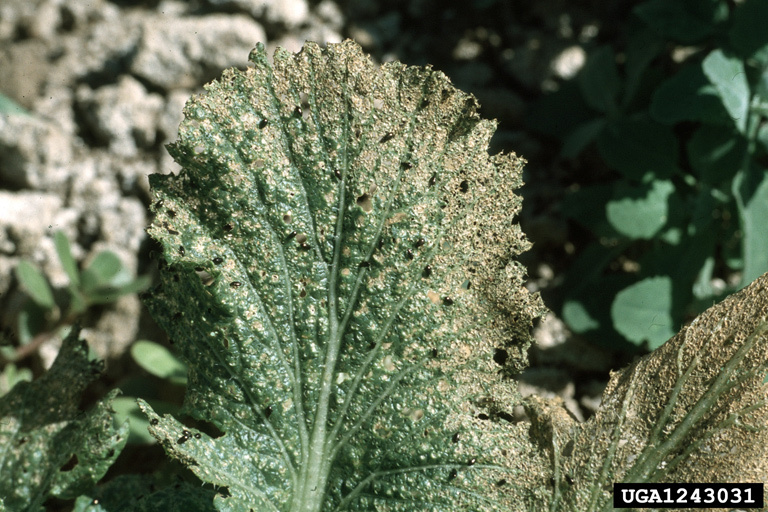
Shothole" damage on chinese cabbage due to crucifer flea beetle
Symptoms
Small holes or pits in leaves that give the foliage a characteristic “shothole” appearance; young plants and seedlings are particularly susceptible; plant growth may be reduced; if damage is severe the plant may be killed; the pest responsible for the damage is a small (1.5–3.0 mm) dark colored beetle which jumps when disturbed; the beetles are often shiny in appearance.
Cause
Insects
Comments
Management
In areas where flea beetles are a problem, floating row covers may have to be used prior to the emergence of the beetles to provide a physical barrier to protect young plants; plant seeds early to allow establishment before the beetles become a problem - mature plants are less susceptible to damage; trap crops may provide a measure of control - cruciferous plants are best; application of a thick layer of mulch may help prevent beetles reaching surface; application on diamotecoeus earth or oils such as neem oil are effective control methods for organic growers; application of insecticides containing carbaryl, spinosad, bifenthrin and permethrin can provide adequate control of beetles for up to a week but will need reapplied.
Large cabbage white (and Cross-Striped Cabbageworm)
Pieres rapae
Evergestis rimosalis
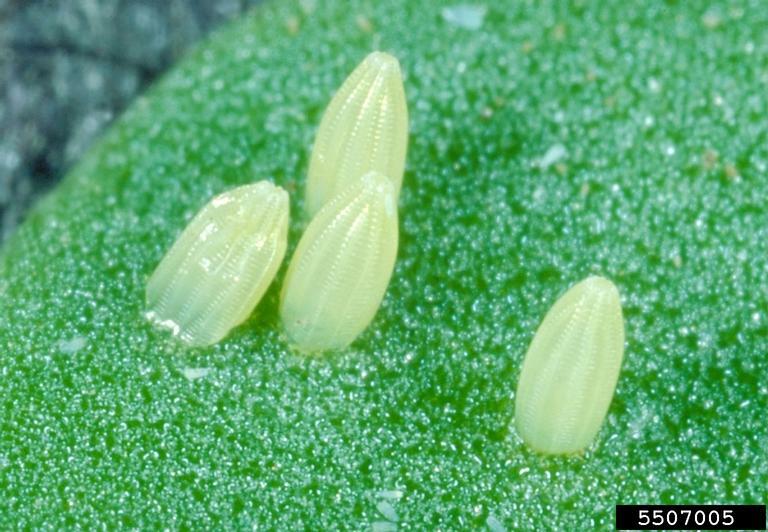
cabbage white (Pieris rapae) eggs

cross-striped cabbageworm on cabbage

Cross striped cabbage worm
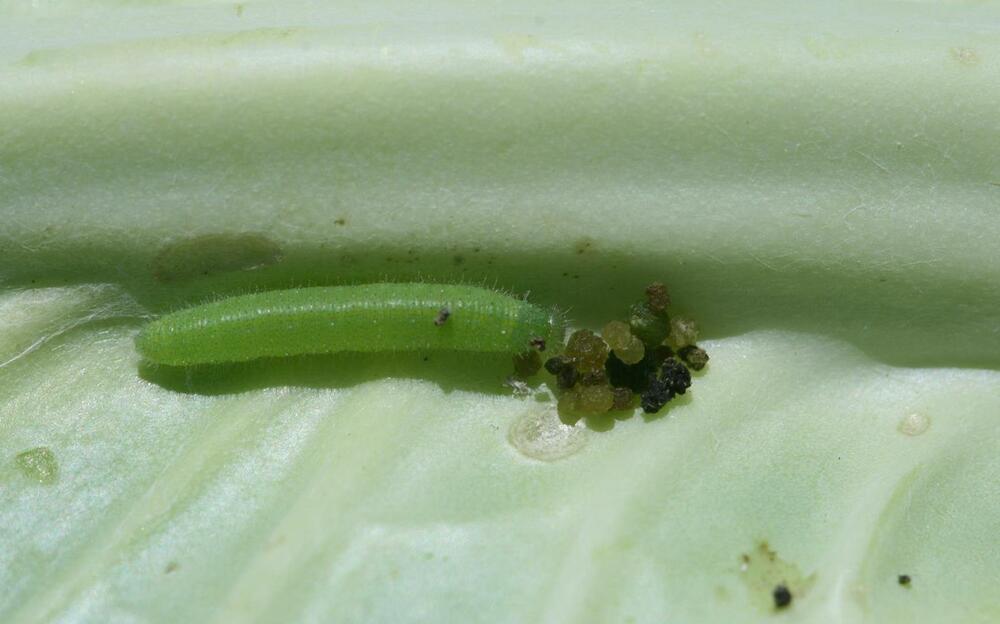
Cabbageworm and frass
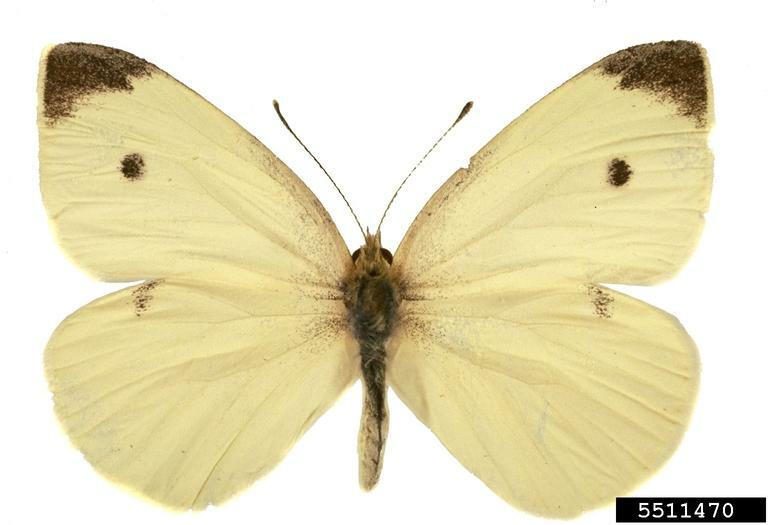
Cabbage white adult

cabbage white (Pieris rapae) adult

cross-striped cabbageworm (Evergestis rimosalis) feeding on leaves
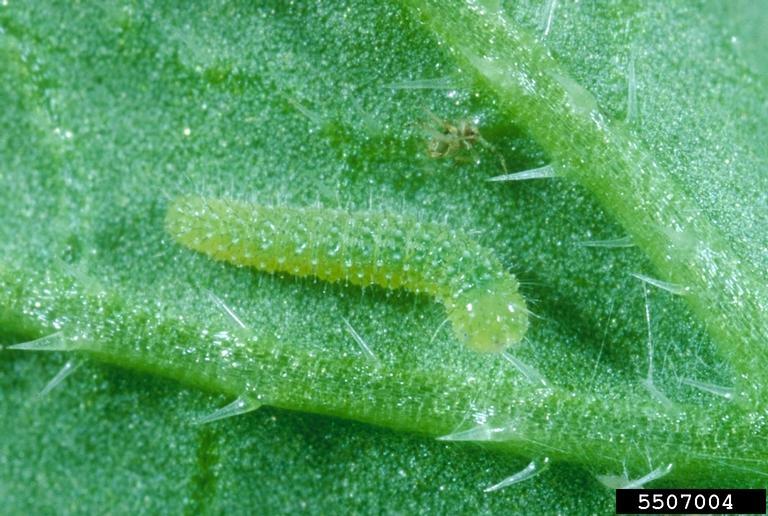
cabbage white (Pieris rapae) early instar larvae

cross-striped cabbageworm on brassica

Cabbage white (Pieres rapae): Pupa of imported cabbageworm (left) and southern cabbageworm (right).
Symptoms
Large ragged holes in leaves or bored into head; green-brown frass (insect feces) on leaves; caterpillar is green in color and hairy, with a velvet-like appearance; may have faint yellow to orange stripes down back; slow-moving compared with other caterpillars.
Cause
Insect
Comments
Management
Hand-pick caterpillars from plants and destroy; scrape eggs from leaves prior to hatching; apply appropriate insecticide if infestation is very heavy.
Thrips (Western flower thrips, Onion thrips, etc.)
Frankliniella occidentalis
Thrips tabaci
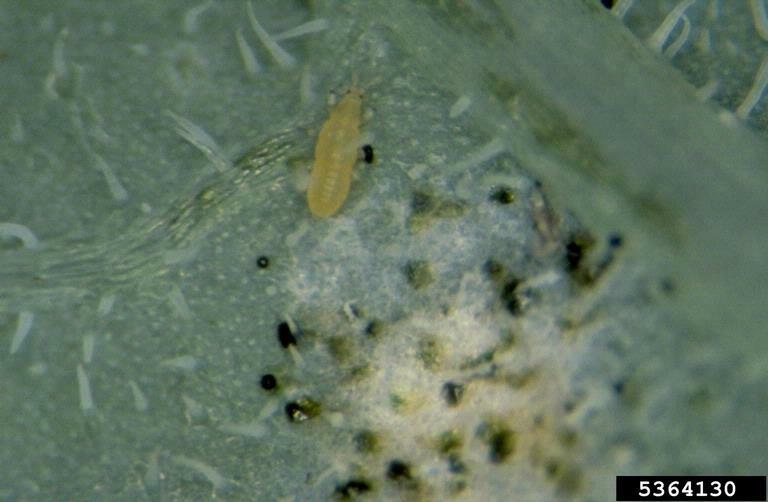
Second instar nymph (and damage to leaf) of the onion thrips (Thrips tabaci).
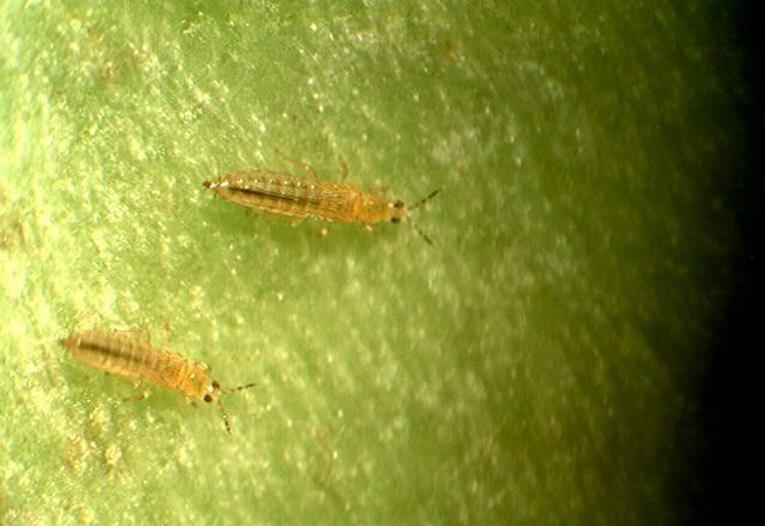
Western flower thrips
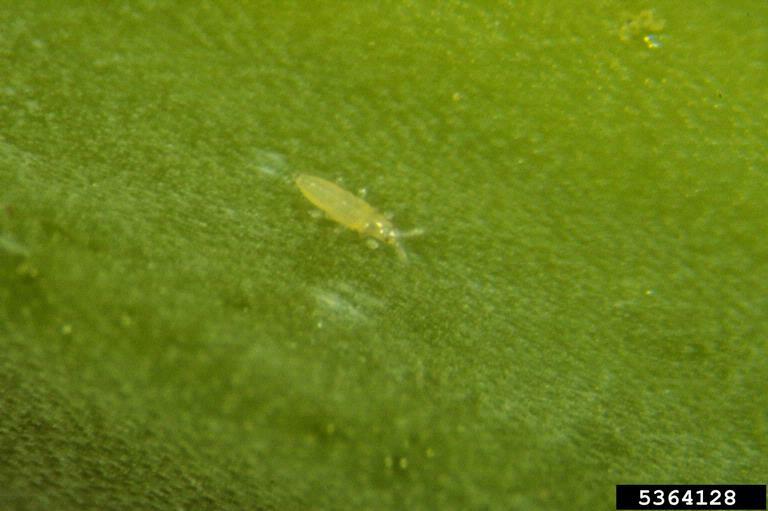
First instar nymph of onion thrips (Thrips tabaci).

Onion thrips (Thrips tabaci)
Symptoms
If population is high leaves may be distorted; leaves are covered in coarse stippling and may appear silvery; leaves speckled with black feces; insect is small (1.5 mm) and slender and best viewed using a hand lens; adult thrips are pale yellow to light brown and the nymphs are smaller and lighter in color.
Cause
Insect
Comments
Management
Avoid planting next to onions, garlic or cereals where very large numbers of thrips can build up; use reflective mulches early in growing season to deter thrips; apply appropriate insecticide if thrips become problematic.
Category : Mites
Root-knot nematode
Meloidogyne spp

Galling on lettuce roots from root-knot nematode

Southern root-knot nematode (Meloidogyne incognita) on cantaloupe root

Root-knot nematode female and egg mass of the root-knot nematode, Meloidogyne sp.
Symptoms
Areas of irregular growth on plant; stunted plant growth; plants wilt during hot afternoons during periods of water-stress; galls on roots
Cause
Nematode
Comments
Management
Rotate crops every 1-2 years to non-host; avoid transferring soil from infested fields; soil fumigation with nematacide or application of non-fumigant nematicide may be required to manage heavy infestations































































